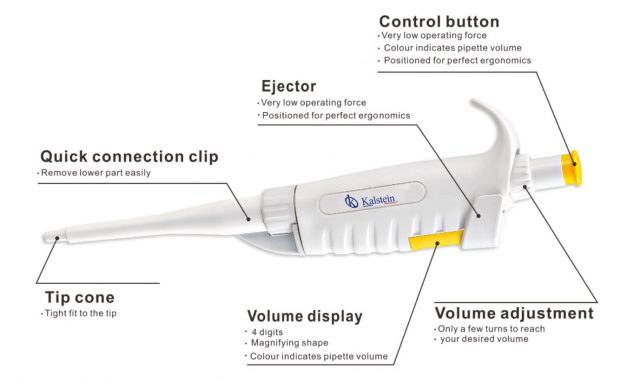Laboratory micropipettes are devices, ideal for liquid measurement needs that are carried out in these places, whether in clinical analysis, experiments or quality control tests. They are part of the laboratory instruments used to absorb and transfer small volumes of liquids.
Micropipettes allow different liquids to be used without having to wash the equipment: for this, disposable plastic tips are used, which are usually sterile, and in turn work with microvolumes, i.e. very small volumes. The volumes that can be captured by these devices vary according to the model and type of pipette: the most common, called p20, p200 and p1000, admit a maximum of 20, 200 and 1000 μl, respectively. Each different size is made to measure liquids within different volume ranges.
The maintenance of the micropipettes is essential to ensure their proper functioning, for this it must be cleaned of any remaining dust that may have fallen on it, this external cleaning must be carried out with 70% ethanol.
Functions of a micropipette
- It is an instrument used to collect samples in very small volumes, in the order of microliters.
- Allows the handling of experimental samples and tests in the different areas in which they are used.
- Allows the analysis of small portions of the sample and its proper distribution if several tests or examinations are to be carried out with it.
How does a micropipette work?
Liquids to be measured or transported are introduced into disposable plastic tips placed at the end of the micropipette shafts instead of the shafts themselves. They also have two main buttons which are the plunger button and the tip ejection button. By pressing the ejector button the micropipette immediately releases the disposable tip at the end of the equipment.
Most micropipette plungers stop at two different positions. Pressing the plunger of a micropipettor down to the second stop stop releases the volume of liquid that was drawn into the micropipettor at the first stop. The volume adjustment dial helps to ensure that a fairly accurate measurement is made, this device is used to adjust the volume of liquid entering the tip of the pipette.
How often should I check and calibrate my pipettes?
You should know that since it is a volumetric device, the micropipettes must be kept properly calibrated, so this process must be carried out regularly. The main factors that will determine the calibration time are:
- Frequency of use.
- Recommendations from the micropipette manufacturer.
- Accuracy and precision required by the operation.
- Nature of the liquid to operate.
- Number of people who operate with the micropipette.
- Number of dispensers.
What do we offer you at Kalstein?
At Kalstein we are manufacturers of laboratory equipment of the highest quality, and designed with the best technology, which is why we offer you the range of YR03731 series micropipettes at the best prices on the market. Our micropipettes of this series have the following characteristics:
- Sterilization at 121 ° C.
- They have robust and precise designs.
- The color indicates the volume of the micropipette.
- Positioned for perfect ergonomics.
For more information we invite you to take a look at our product catalogue HERE

